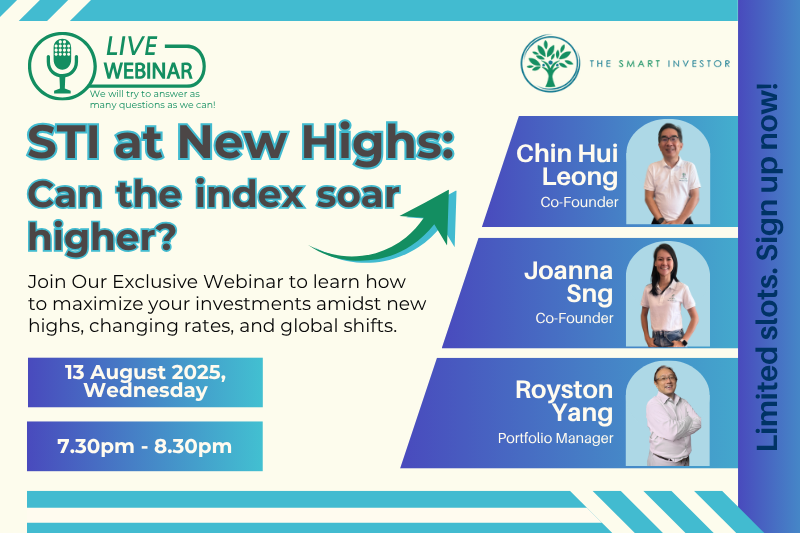Many Singapore investors love dividends, and for good reason.
There’s something satisfying about getting a steady stream of income just for holding onto your shares.
It’s one of the best perks of being patient and thinking long term.
But here’s the catch: Some folks get a little too excited about the dividend.
They jump in without looking at what’s actually behind those numbers.
Let’s break down three mistakes everyone keeps falling into, and then get into some real ways to build an income portfolio that actually lasts.
Mistake 1: Confusing High Yield with High Return
Big, flashy yields of 8% to 10%, or even higher, always grab attention.
But honestly, they’re usually a warning sign.
When you see high yields like that, it often means the company’s struggling.
Maybe its earnings are slipping, cash flow’s drying up, or it’s getting ready to cut its dividend.
Most of the time, a sky-high yield exists not because the company is feeling generous, but because the stock price is tanking.
Picture this: a company paid a S$0.20 dividend last year and trades at S$4. That’s a 5% yield. If the price gets cut in half to S$2, the yield shoots up to 10%.
But in such cases, the market may be screaming, “Something’s wrong.”
A well-known case is Hyflux.
People once talked about the company like it was Singapore’s poster child for water treatment and sustainable infrastructure.
Hyflux ran desalination and power plants across the region, positioning itself as a real national champion.
At some point before its collapse, Hyflux started issuing perpetual securities and preference shares, promising yields of more than 6% in some cases.
Income-hungry investors lined up. But the company’s profits and cash flow didn’t back up those payouts.
Debt piled on, projects flopped, and by 2021, Hyflux was under judicial management. Investors lost everything.
That’s what happens when a high yield covers up financial problems. If you want to sleep at night, look for companies with dividends they can actually afford.
Here’s what that looks like in practice. Mapletree Industrial Trust (SGX: ME8U) had a distribution per unit of S$0.1357 for FY24/25, a 1.04% year-on-year (YoY) increase.
The DPU for H1 FY25/26 landed at S$0.0645, 5.1% lower than a year ago. But the drop was driven by missing one-off divestment gains and some pressure from foreign exchange – these are not structural issues.
Mapletree Industrial Trust’s balance sheet also looks solid with an aggregate leverage ratio of 37.3%, and an interest coverage ratio of 3.9, as of 30 September 2025.
In addition, the REIT’s portfolio occupancy also held steady at a respectable 91.3%.
With the unit price sitting at S$2.04 on 19 November 2025, investors are looking at a trailing distribution yield of 6.3%.
Besides the robust balance sheet and respectable portfolio occupancy, Mapletree Industrial Trust’s distribution yield is also backed by steady increases in DPU over the long-term.
For example, 10 years ago in FY14/15, its DPU was S$0.1043, and as mentioned earlier, its DPU in FY24/25 was S$0.1357, 30% higher.
Bottom line?
A dependable 6%-7% yield from a well-run trust wins out over chasing double-digit yields that only look good on paper but crumble with unstable payouts or falling prices.
Mistake 2: Ignoring Dividend Sustainability
Headlines love big dividend numbers, but what actually counts is whether the company can keep those payments coming.
Steady dividends come from businesses that actually make money, have cash in the bank, and aren’t buried in debt.
When a company owes too much and shells out nearly everything it earns, that’s not stability, but a high-wire act.
The moment the economy stumbles or interest rates climb, those payouts start to look shaky. Dividends propped up by loans or selling off assets don’t tend to last.
Look at Keppel Infrastructure Trust (SGX: A7RU).
This is what a resilient income portfolio should look like.
The business trust owns and runs power, energy, and waste management assets in a number of geographies, including Australia and New Zealand, Singapore, Saudi Arabia, Europe, and South Korea..
In H1 2025, Keppel Infrastructure Trust’s distributable income jumped 31.2% YoY to S$119.4 million.
That’s thanks to steady performance from City Energy and IXOM, along with new additions like Ventura in Australia (acquired in June 2024).
Keppel Infrastructure Trust’s DPU for H1 2025 was S$0.0197, which is a 1% bump from a year ago.
Investors are getting a 8.5% yield for Keppel Infrastructure Trust based on its trailing DPU and share price of S$0.46 as of 19 Nov 2025.
This isn’t fleeting. Keppel Infrastructure Trust’s income comes from recurring cash flow locked in by long-term contracts with governments and utilities.
The increase in its DPU in H1 2025 also follows a string of annual increases in DPU (excluding special distributions) from S$0.0372 in 2020 to S$0.039 in 2024.
It’s worth noting too that Keppel Infrastructure Trust’s DPU in 2020 – the year of COVID – was unchanged from 2019.
Moreover, Keppel Infrastructure Trust has a decent balance sheet.
Net gearing stands at 39.3%, and about 80% of its debt are on fixed rates or are hedged.
Keppel Infrastructure Trust proves you can get sustainable high yields from solid assets and disciplined management, not financial tricks.
Mistake 3: Overloading on REITs and Income Plays
Singapore investors love REITs for their regular distributions, but concentrating too heavily on them can be risky.
When interest rates climb, REITs end up paying more to refinance their debt and sometimes have to trim their distributions as a result. The same headache also hits utilities and infrastructure trusts that lean on debt to grow.
We saw this play out between 2022 and 2024, when global rates surged and stayed high. A number of leveraged REITs were forced to juggle higher borrowing costs, softer valuations, and weaker distributions.
Their unit prices fell, yields spiked, and investors who piled in for the fat distributions saw their capital shrink instead of grow.
Taking a look at Suntec REIT (SGX: T82U), when global interest rates first surged during its FY2022, Suntec still managed a total DPU of S$0.08884.
But the pressure from higher borrowing costs quickly crept in.
By FY2023, its full-year DPU had already fallen sharply to S$0.07135, a drop of 19.7%, as financing costs climbed and capital distributions shrank.
The squeeze continued into FY2024, when total DPU fell again to S$0.06192 cents, down 13.2% YoY.
In H1 2025, Suntec REIT’s performance stabilised.
Distributable income rose 4.6% YoY to S$92.8 million, while DPU increased 3.7% to S$0.03155, supported by steady contributions from its Singapore, UK, and Australian properties.
But the underlying risks haven’t gone away.
Gearing remains high at 42.3%, and any rebound in interest rates could once again lift refinancing costs and squeeze future distributions.
Suntec’s journey from 2022 to 2024 shows how a seemingly attractive yield can mask the strain of rising leverage and shrinking payouts.
Now let’s look at a different story.
ST Engineering (SGX: S63) doesn’t offer a huge yield.
It has a trailing dividend of S$0.17 per share for, which works out to a dividend yield of about 2% at recent share prices.
In 2022 and 2023, ST Engineering kept its dividend steady at S$0.16 per share, even as interest rates surged globally.
There were no cuts, no shocks. It was just stability supported by recurring revenue streams in defence, aerospace and smart-city solutions.
Then came 2024.
Revenue climbed 12% YoY to S$11.28 billion, while net profit surged 20% to S$702 million.
The company generated S$1.72 billion in operating cash flow, tightened cost ratios, and ended the year with a record S$28.5 billion order book, which gave it near-term earnings visibility.
With this strength, ST Engineering raised its total dividend in 2024 to S$0.17 per share.
This momentum carried into 2025.
In 9M 2025, ST Engineering’s revenue rose 9% YoY to S$9.1 billion, with strong contributions from all three major segments.
The order book climbed even higher to S$32.6 billion as of end-September 2025, after securing S$14.0 billion in new contracts year-to-date.
With profitability expanding and divestments unlocking S$594 million in cash, ST Engineering’s management expects 2025’s total dividend to be S$0.23 per share, of which S$0.12 per share in interim dividends for 9M 2025 have been declared, and a special dividend of S$0.05 has been proposed.
ST Engineering also has a sturdy balance sheet.
As of 30 June 2025, it has net debt of S$5.16 billion against S$2.71 billion in shareholders’ equity and S$1.72 billion in operating cash flow (for 2024).
All this paints a clear contrast.
While a leveraged REIT such as Suntec REIT struggled through the 2022–2024 rate hike, ST Engineering continued growing its revenue, earnings, and dividends, powered by long-cycle contracts, diversified business lines and a resilient balance sheet.
That’s why ST Engineering’s lower headline yield is misleading: The company delivers something far more important for long-term income investors, which is a payout that grows because the business grows.
Diversification really makes a difference here.
The best way to handle yield risk in this case is to put together a portfolio that combines solid income with steady growth.
Think about holding reliable REITs like Mapletree Industrial Trust, throw in something from the infrastructure side like Keppel Infrastructure Trust, and don’t forget a long-term growth pick such as ST Engineering.
With this kind of mix, you’re ready for whatever comes: interest rate changes, property market ups and downs, all without giving up on strong returns over time.
What This Means for Investors
Chasing high yields without thinking things through usually ends in disappointment: dividend cuts, losing money, and just bad long-term results.
Instead of obsessing over big payouts, focus on what’s actually powering those dividends.
The best income portfolios are built on companies with steady cash flow, reasonable debt, and a habit of paying out even when the market gets rough.
Spread your investments across different sectors and mix up your yield levels too. That way, you lower your risk and your income doesn’t lurch up and down.
In the end, the right dividend strategy is the one that lets you relax and actually get some sleep at night.
Get Smart: Look Beyond the Yield
Big yields often come with big risks. The highest-paying stocks in any given year rarely deliver the best total returns.
True income investing is about owning companies that can keep paying you, and even grow those payments through economic cycles.
Investors should not focus on today’s yield, but on whether that income will still be there tomorrow.
If you want to retire with a constant stream of dividends, these 5 stocks might be all you need. We’ve found 5 SG stocks that have kept paying (and growing) through inflation, rate hikes, and recessions. See what they are with our latest free report for SGX dividend investors. Click here to get instant access.
Follow us on Facebook, Instagram and Telegram for the latest investing news and analyses!
Disclosure: Joseph Gan does not own shares in any of the companies mentioned.





